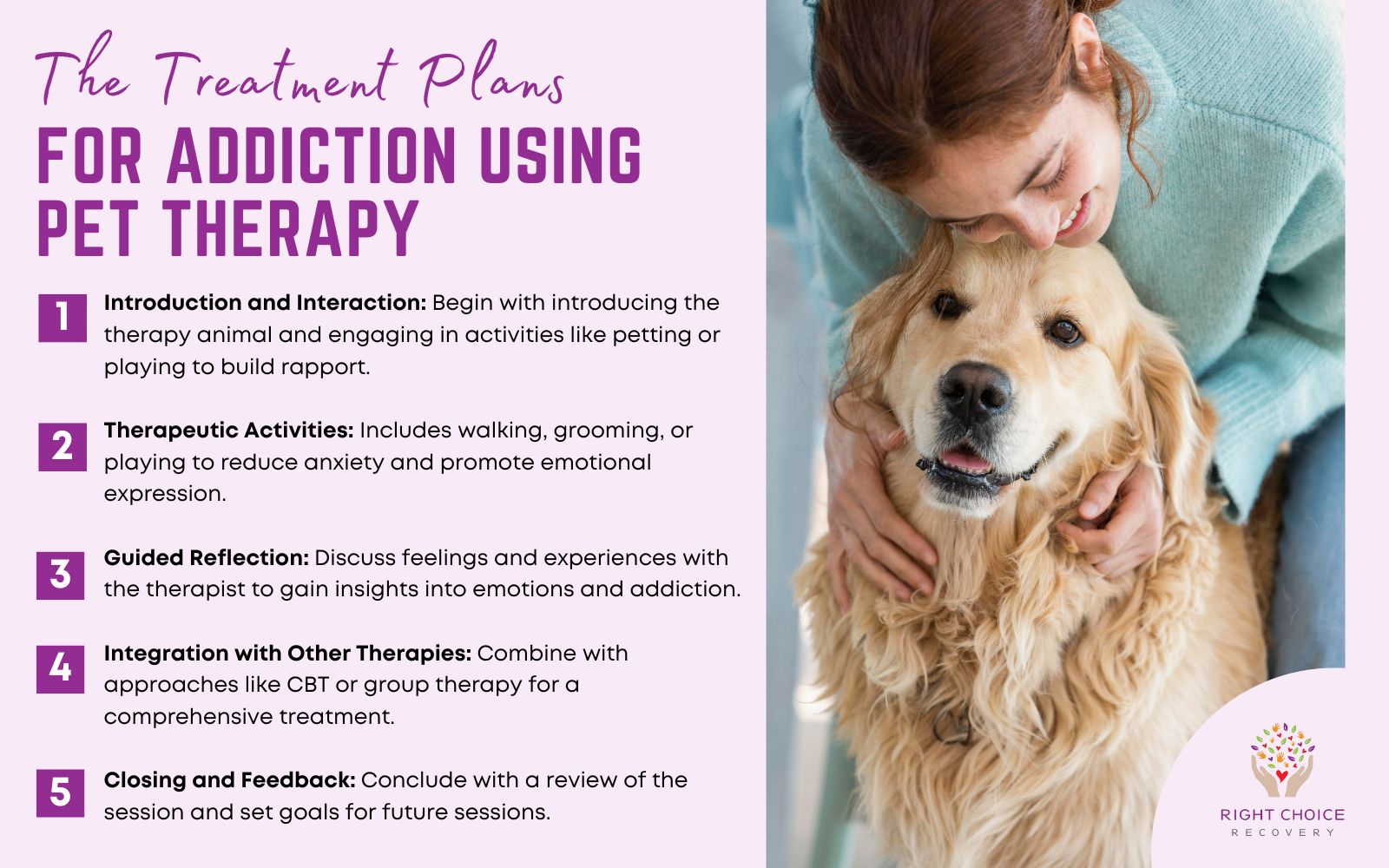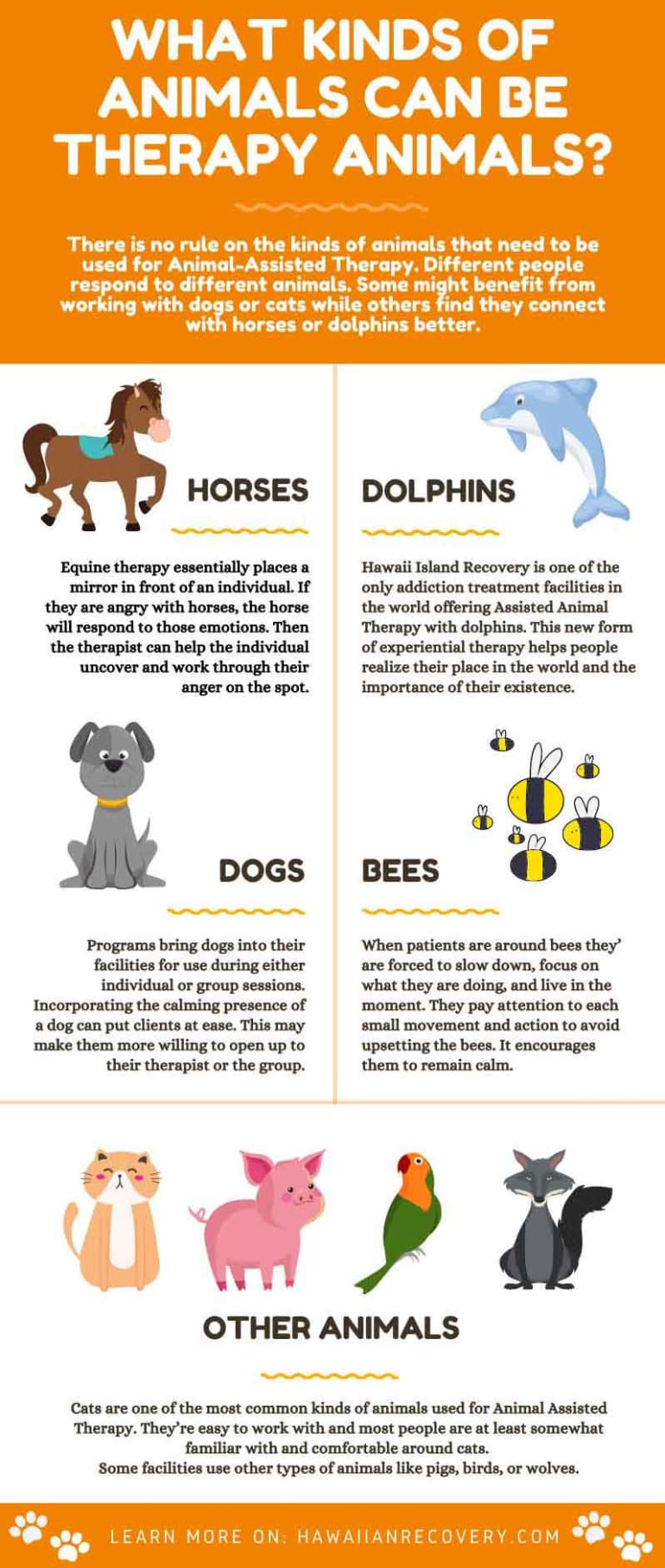Key Takeaways
Animal-assisted interventions (AAI) are effective in supporting addiction recovery by improving emotional well-being and reducing stress.
Common animals used in AAI include dogs, horses, cats, rabbits, and birds, each offering unique therapeutic benefits.
Canine therapy is popular due to dogs’ ability to provide companionship and reduce anxiety.
Equine therapy involves horses and helps improve self-awareness, emotional regulation, and social skills.
Implementing AAI in rehab requires proper training, certification, and consideration of legal and ethical guidelines.
The Role of Animals in Addiction Rehab and Recovery
Animal-assisted interventions (AAI) have emerged as a powerful tool in addiction rehab and recovery. By integrating animals into therapeutic settings, individuals can experience unique emotional and psychological benefits that traditional therapies may not provide. The presence of animals can foster a sense of calm and connection, helping individuals open up and engage more fully in their recovery journey.
“Pet Therapy in Addiction Treatment …” from rightchoicerecoverynj.com and used with no modifications.
Animal Assisted Interventions: An Overview
AAI encompasses a range of therapeutic practices that incorporate animals to improve the emotional, cognitive, and social functioning of individuals in recovery. This approach is not limited to one type of animal; it can include dogs, horses, cats, rabbits, and even birds, each offering distinct benefits tailored to the therapeutic goals of the program.
Benefits of Engaging Animals in Therapy
Engaging animals in therapy offers numerous benefits that can significantly aid in addiction recovery. These benefits include:
Emotional Support: Animals provide unconditional love and companionship, which can help reduce feelings of loneliness and isolation.
Stress Reduction: Interacting with animals has been shown to lower stress levels and increase feelings of relaxation and calmness.
Improved Social Skills: Working with therapy animals can enhance communication and social interaction skills, which are crucial for building healthy relationships.
Increased Motivation: The presence of animals can motivate individuals to participate more actively in therapy sessions and adhere to treatment plans.
Exploring Types of Animal Assisted Interventions
There are several types of animal-assisted interventions, each utilizing different animals to achieve specific therapeutic outcomes. Let’s explore some of the most common types:
Canine Therapy: Dogs in Action
Dogs are perhaps the most popular animals used in therapy due to their friendly and social nature. Canine therapy involves trained therapy dogs that work alongside therapists to support individuals in recovery. These dogs help create a safe and comforting environment, allowing individuals to express themselves more openly.
One of the key advantages of canine therapy is the strong bond that often forms between the individual and the dog. This bond can help reduce anxiety, improve mood, and increase feelings of self-worth. Additionally, caring for a dog can instill a sense of responsibility and routine, which is beneficial for those in recovery.
Equine Therapy: Horses at the Helm
Equine therapy, also known as horse therapy, involves interacting with horses as a means of emotional and psychological healing. Horses are highly intuitive animals, capable of reflecting the emotions and behaviors of the individuals they interact with. This makes them excellent partners in therapy, as they can help individuals gain insight into their own emotional states and behaviors.
Through activities such as grooming, leading, and riding horses, individuals can develop greater self-awareness, emotional regulation, and social skills. Equine therapy is particularly effective for those who may struggle with trust and communication, as it encourages the development of these skills in a non-judgmental setting.
Exotic and Small Animal Therapy: Beyond the Common Choices
In addition to dogs and horses, other animals such as cats, rabbits, and birds are also used in therapy. These smaller and often more exotic animals can provide a different kind of therapeutic experience. For example, the gentle nature of rabbits can help soothe anxiety, while the playful antics of birds can bring joy and laughter to therapy sessions.
Using a variety of animals in therapy allows for a more personalized approach, catering to the individual preferences and needs of those in recovery. This diversity in animal-assisted interventions ensures that there is an option available for everyone, regardless of their comfort level with different animals.
“Animal-assisted Therapy | Hawaii Island …” from hawaiianrecovery.com and used with no modifications.
Animals Commonly Used in Therapy
Animal-assisted therapy is a versatile approach that can involve a wide range of animals, each bringing unique qualities to the therapeutic process. From the loyal companionship of dogs to the gentle presence of rabbits, these animals play crucial roles in enhancing the recovery journey for individuals overcoming addiction.
Advantages of Dogs in Therapeutic Settings
Dogs are often at the forefront of animal-assisted therapy due to their innate ability to form strong, trusting bonds with humans. Their playful and affectionate nature makes them ideal companions in therapeutic settings. Dogs help reduce anxiety and promote a sense of safety and comfort, which is vital for individuals in recovery. Their presence can encourage patients to engage more openly in therapy, fostering a supportive environment that enhances emotional healing.
Horses: Unique Qualities and Therapeutic Benefits
Horses bring a unique set of qualities to therapy, making them valuable partners in the healing process. Their size and sensitivity require individuals to approach them with respect and calmness, promoting self-awareness and emotional regulation. Engaging with horses through activities like grooming or riding can help individuals develop trust and communication skills.
Equine therapy is particularly effective for those dealing with trauma or emotional challenges, as horses can mirror the emotions of the individuals they interact with. This mirroring effect provides valuable feedback, helping individuals recognize and address their emotional states in a supportive and non-judgmental setting.
Role of Cats, Rabbits, and Birds
While dogs and horses are popular choices, smaller animals like cats, rabbits, and birds also have their place in therapy. Cats, with their calming presence and independent nature, can help reduce stress and anxiety. Their gentle purring can create a soothing environment, encouraging relaxation and emotional well-being.
Rabbits, known for their gentle demeanor, are excellent for those who may be apprehensive around larger animals. Their soft fur and calm presence can be particularly comforting, helping individuals feel more at ease during therapy sessions. Birds, with their vibrant personalities and melodic sounds, can bring joy and lightness to the therapeutic environment, lifting spirits and encouraging positive interactions.
Implementing Animal Assisted Therapy in Rehab
Integrating animal-assisted therapy into rehab programs requires careful planning and consideration. It involves selecting the right animals, training them for therapeutic work, and ensuring that facilities are equipped to support both the animals and the individuals in recovery. By addressing these key elements, rehab centers can create a supportive environment that maximizes the benefits of animal-assisted interventions.
One of the first steps in implementing animal-assisted therapy is choosing animals that are well-suited to the therapeutic goals of the program. It’s essential to consider the temperament, behavior, and needs of the animals to ensure they can effectively support individuals in recovery.
Training and Certification for Therapy Animals
Training and certification are crucial components of successful animal-assisted therapy. Animals must undergo rigorous training to ensure they are comfortable and safe in therapeutic settings. This training includes socialization, obedience, and exposure to various environments and situations.
Certification by recognized organizations is often required to validate the animal’s readiness for therapy work. This certification process ensures that therapy animals meet specific standards of behavior and reliability, providing peace of mind to both therapists and individuals in recovery.
Setting Up Facilities for Animal Assisted Therapy
Creating a suitable environment for animal-assisted therapy involves setting up facilities that cater to the needs of both the animals and the individuals in recovery. These facilities should provide adequate space for interaction, safety measures to protect both parties, and resources to support the well-being of the therapy animals.
Rehab centers must also consider the logistics of integrating animals into their programs, such as scheduling sessions, managing animal care, and ensuring that staff members are trained to facilitate therapy sessions effectively.
Legal and Ethical Considerations
Implementing animal-assisted therapy also requires attention to legal and ethical considerations. It’s essential to comply with regulations regarding animal welfare, therapy standards, and patient confidentiality. Rehab centers must ensure that therapy animals are treated with care and respect, with their health and well-being prioritized.
Ethical considerations also involve obtaining informed consent from individuals participating in animal-assisted therapy, ensuring they understand the role of the animals and the potential benefits and risks involved. By addressing these legal and ethical aspects, rehab centers can create a safe and effective therapeutic environment for all participants.
How Animal Assisted Therapy Aids in Addiction Recovery
Animal-assisted therapy (AAT) plays a vital role in addiction recovery by offering unique emotional and psychological benefits that complement traditional treatment methods. By incorporating animals into therapy sessions, individuals can experience increased motivation, reduced stress, and improved emotional regulation. These benefits can make a significant difference in the recovery process, providing individuals with the support they need to overcome addiction challenges.
Emotional and Mental Health Benefits
One of the primary benefits of AAT is its ability to enhance emotional and mental health. The presence of therapy animals can help reduce anxiety and depression, common challenges faced by individuals in recovery. Animals offer unconditional love and companionship, which can help individuals feel valued and understood, fostering a sense of belonging and emotional stability.
Moreover, interacting with therapy animals can increase levels of oxytocin, a hormone associated with feelings of happiness and relaxation. This hormonal boost can contribute to improved mood and emotional resilience, helping individuals cope with the stresses of recovery more effectively.
Socialization and Behavioral Improvements
Animal-assisted therapy also promotes socialization and positive behavioral changes. Working with therapy animals encourages individuals to develop better communication and interpersonal skills, which are crucial for building healthy relationships. These interactions can help individuals practice empathy, patience, and trust, all of which are essential for successful recovery and reintegration into society.
Furthermore, the responsibility of caring for therapy animals can instill a sense of purpose and routine, helping individuals develop healthier habits and behaviors. This newfound structure can support individuals in maintaining sobriety and making positive life choices.
Potential Challenges and Limitations
While AAT offers numerous benefits, it is not without its challenges and limitations. One potential challenge is the need for proper training and certification of therapy animals to ensure their safety and effectiveness in therapeutic settings. Additionally, not all individuals may be comfortable or receptive to working with animals, which can limit the therapy’s effectiveness for some.
There are also logistical considerations, such as the availability of trained therapy animals and the resources needed to support their care and well-being. It’s essential for rehab centers to address these challenges to ensure the successful implementation of AAT in their programs.
Frequently Asked Questions
Animal-assisted therapy is a growing field, and many people have questions about its implementation and effectiveness in addiction recovery. For more information, you can explore animal-assisted therapy for treating substance use disorders. Here are some of the most frequently asked questions:
What animals are most effective in addiction therapy?
While dogs and horses are among the most commonly used animals in therapy due to their social nature and ability to form strong bonds with humans, other animals such as cats, rabbits, and birds can also be effective. The choice of animal often depends on the individual’s preferences and the specific therapeutic goals of the program.
How is animal assisted therapy integrated into treatment programs?
Integrating AAT into treatment programs involves careful planning and coordination. It starts with selecting suitable therapy animals and ensuring they are properly trained and certified. Rehab centers must also create an environment that supports the well-being of both the animals and the individuals in recovery. This includes setting up facilities, scheduling sessions, and training staff to facilitate therapy effectively.







